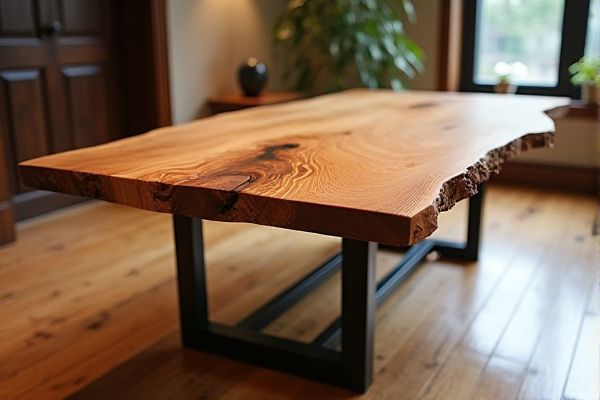
Live edge tables preserve the natural contours and unique character of the wood, offering a rustic and organic aesthetic, while polished wood tables feature smooth, refined surfaces with a more formal and elegant appearance. Explore the rest of the article to discover which style best suits Your home and lifestyle.
Table of Comparison
| Feature | Live Edge Table | Polished Wood Table |
|---|---|---|
| Design | Natural, rustic, retains tree's natural edge | Sleek, smooth surface with refined edges |
| Material | Solid wood slab with natural bark or live edge | Solid or engineered wood with sanded, polished finish |
| Finish | Minimal processing, sometimes oil or matte finish | High gloss or satin polish for smooth texture |
| Durability | Durable but less uniform surface | Durable and resistant to scratches, easy to clean |
| Maintenance | Requires occasional oiling to preserve wood | Regular cleaning, occasional re-polishing |
| Aesthetic Appeal | Unique, organic look emphasizing natural beauty | Classic, elegant, fits modern and traditional styles |
| Cost | Generally higher due to customization and wood quality | Varies widely; often more affordable and mass-produced |
| Common Usage | Statement pieces, artistic furniture, dining tables | Office desks, dining tables, cabinetry |
Introduction to Live Edge and Polished Wood Tables
Live edge tables showcase the natural contours and imperfections of the wood, preserving its organic beauty and unique grain patterns, making each piece one-of-a-kind. Polished wood tables feature smooth surfaces with refined finishes that highlight the wood's color and texture while providing a sleek, elegant look suitable for formal settings. Choosing between live edge and polished wood tables depends on your preference for rustic authenticity versus modern sophistication in your interior design.
Defining Live Edge Tables
Live edge tables showcase the natural contours and raw edges of the wood slab, preserving the tree's original shape for a rustic, organic aesthetic. Unlike polished wood tables, which feature smooth, uniform surfaces achieved through sanding and finishing, live edge tables emphasize the wood's natural grain, knots, and imperfections. Your choice between the two depends on whether you prefer a unique, nature-inspired piece or a sleek, refined look.
Understanding Polished Wood Tables
Polished wood tables showcase a smooth, glossy finish achieved through sanding and coating processes, highlighting the natural grain while providing durability and resistance to stains and scratches. This refined surface enhances light reflection, creating an elegant aesthetic often favored in formal settings. Compared to live edge tables, polished wood tables offer a more uniform, sleek appearance that complements modern and traditional interior designs.
Aesthetic Differences: Natural vs. Refined
Live edge tables showcase the natural contours and organic imperfections of the wood, emphasizing rustic beauty and unique character in each piece. Polished wood tables offer a refined, smooth surface with a glossy finish, highlighting craftsmanship and elegance through uniformity. Your choice between these styles reflects a preference for raw, natural aesthetics versus a sleek, sophisticated appearance.
Material Selection and Wood Types
Live edge tables often showcase natural, raw wood edges, emphasizing unique grain patterns and knots from hardwood species like walnut, oak, or cherry, highlighting organic aesthetics and structural integrity. Polished wood tables prioritize smooth, finished surfaces created from hardwoods such as maple, mahogany, or birch, enhancing durability and refined appearance through sanding and varnishing. Material selection for live edge tables leans toward slabs retaining natural features, whereas polished tables favor uniformly processed wood for consistent texture and sheen.
Craftsmanship and Production Techniques
Live edge tables showcase craftsmanship through the preservation of natural wood patterns and organic shapes, often crafted by skilled artisans who highlight the wood's raw beauty. Polished wood tables involve precise sanding, staining, and finishing techniques that require meticulous attention to detail for a smooth, refined surface. Your choice reflects a preference for either the rugged, natural artistry of live edge craftsmanship or the sleek, engineered perfection of polished wood production.
Durability and Maintenance Considerations
Live edge tables feature natural, irregular edges that preserve the wood's original shape, often requiring regular sealing to protect against moisture and wear, making maintenance more hands-on. Polished wood tables offer a smooth, sealed surface that resists stains and scratches better, providing easier upkeep through simple cleaning and occasional refinishing. Your choice depends on whether you prioritize the rustic charm and natural texture of live edge wood, which demands careful care, or the sleek durability and low-maintenance benefits of polished wood surfaces.
Cost Comparison: Live Edge vs. Polished Wood
Live edge tables generally command higher prices due to the unique natural shapes and craftsmanship required, often ranging from $800 to over $3,000 depending on wood type and size. Polished wood tables are typically more affordable, with prices commonly between $300 and $1,200, influenced by mass production and smoother manufacturing processes. Cost-effectiveness depends on budget and preference for organic aesthetics versus refined finishes.
Ideal Spaces and Interior Design Compatibility
Live edge tables bring a natural, rustic charm ideal for organic, bohemian, or farmhouse interiors, seamlessly blending with uneven textures and raw materials. Polished wood tables suit modern, minimalist, or classic settings, offering sleek surfaces that enhance elegance and formality with clean lines and refined finishes. Both styles complement diverse interior designs by either emphasizing natural imperfection or refined craftsmanship, depending on the desired aesthetic and spatial functionality.
Choosing the Right Table for Your Lifestyle
Live edge tables offer a natural, rustic aesthetic with unique wood grain patterns that suit homes aiming for an organic, artisanal feel, while polished wood tables provide a sleek, refined look ideal for modern or formal settings. Consider durability and maintenance; live edge furniture often requires special care to protect the raw edges, whereas polished tables are easier to clean and typically more resistant to stains. The choice depends on lifestyle factors such as usage frequency, preferred style, and willingness to maintain the table's surface condition.
 homyna.com
homyna.com